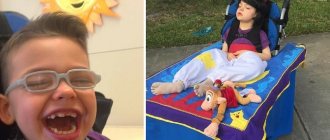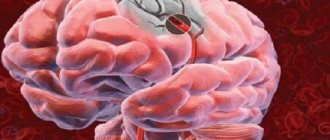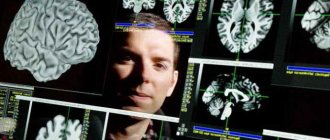Despite the fact that Rett syndrome is a congenital disease, for the first six months parents may not even be aware of the existing abnormalities in the child. Another difficulty lies in the fact that the symptoms of this pathology are in many ways similar to other diseases. This disorder was first discovered and described in his scientific research by the Austrian physician Andreas Rett in the mid-20th century. What is Rett syndrome and why does it occur in children? What are the symptoms of the disease and what treatment methods are there? How to properly care for such a child and is it possible to prevent pathology?
Rett syndrome in children - what is it?
Rett syndrome is a genetic degenerative disorder characterized by neurodevelopmental disorders that causes progressive mental retardation in girls and, less commonly, in boys. The disease affects the gray matter of the brain and is therefore accompanied by various kinds of neurological disorders, autistic behavior, etc. These children experience scoliosis (curvature of the spine), epileptic seizures, gastrointestinal disorders and a number of other associated symptoms.
The first symptoms of the disease can be detected at the age of 4-6 months.
History[ | ]
Despite the widespread version that the syndrome was first described in 1966, it was discovered in 1954, and received worldwide recognition as a separate disease in 1983.
In 1954, Andreas Rhett examined two girls and noted in them, in addition to regression of mental development, special stereotypical movements in the form of “squeezing hands” or reminiscent of “washing hands.” In his notes, he found several similar cases, which prompted him to think about the uniqueness of the disease. After filming his patients, Dr. Rhett traveled throughout Europe in search of children with similar symptoms. In 1966 in Austria, he published his research in a couple of German journals, but it did not receive worldwide publicity, even after publication in English in 1977. Only in 1983, after the publication of the Swedish researcher Dr. Bengt Hagberg and his colleagues [2], the disease was identified as a separate nosological unit and named “Rett syndrome” in honor of its discoverer.
Causes of the disease
Despite the obvious hereditary predisposition, the causes of the disease are not fully understood. Thus, experts identify a number of hypotheses that explain the mechanism of development of this pathology:
- A genetic mutation caused by existing blood ties (and the more there are, the higher the likelihood of having a sick child). The disease develops during fetal development and affects the rest of life.
- Chromosomal disorders. Scientists suggest that the damaged gene is located on the X chromosome, one of the sections of which is responsible for this deviation.
- Metabolic abnormalities. Some doctors believe that changes in blood composition may be one of the reasons for the development of Rett syndrome. In particular, atypical levels of lymphocytes and myocytes were found in sick children.
But, probably, all three of the above factors influence the formation of the disease. It is quite possible that in the future scientists will be able to understand this problem in more detail and find out other causes of the disorder.
For every 10-15 thousand children, one child is born with such a genetic anomaly.
“Very worrying”: how a new childhood syndrome is related to COVID-19
In the last two weeks, amid a pandemic, about a hundred cases of an unusual inflammatory syndrome in children have been identified in some European countries and the United States. Doctors suggest that it is deadly and may be associated with coronavirus.
As French physician Isabelle Cohn-Po emphasized in a conversation with the La Figaro newspaper, most often this syndrome affects children from two to ten years of age. However, they usually do not have any concomitant or chronic diseases.
The New York Times notes that so far not a single child has died from the new syndrome, although some of the patients have been placed in intensive care and connected to mechanical ventilation devices (ventilators).
For example, on April 23, in Richmond Hill, New York, Queens, USA, eight-year-old Jayden Hardovar felt unwell - he developed a slight fever. The child spent several days in bed, and on April 29, while watching cartoons, he suddenly stopped breathing. His 15-year-old brother, being a Boy Scout, began to provide first aid to the boy - it was thanks to this that he was saved before the ambulance arrived. The child was under mechanical ventilation for three days and only then began to recover.
Experts have already called this syndrome “childhood multisystem inflammatory,” Stephen Kearney, head of the department of pediatric critical care medicine at Columbia University, told The New York Times. At the same time, however, the symptoms are very similar to Kawasaki syndrome - and it is already known to doctors.
“This syndrome has been familiar to medicine for a long time. It was first described in Japan and is quite rare. During my practice, I only saw a child with Kawasaki once,” immunologist Vladimir Bolibok told KP radio.
According to him, this syndrome is expressed in inflammation of large vessels and begins gradually - usually its cause is a history of acute respiratory viral infection.
“The temperature lasts for several days or even weeks, then a rash and shortness of breath appear,”
— the doctor described the symptoms of Kawasaki.
According to Stephen Kearney, the clinical picture of the new syndrome is very similar to the manifestations of a new type of coronavirus, so there is a possibility that similar symptoms in the current increasing cases are caused by COVID-19. “It may well be that this syndrome is one of the manifestations of COVID-19. Why did this start now? Perhaps the virus has acquired another mutation,” Bolibok also suggested.
Indeed, cases of the new syndrome began to appear a month after the surge of COVID-19 - according to Leonard Krylov, head of the pediatrics department at Winthrop Hospital in New York, this is enough time for the coronavirus to provoke an immune response in children. This means that multisystem inflammatory syndrome may be that very reaction of the immune system, the doctor believes. In addition, some patients hospitalized with similar symptoms actually had antibodies to the coronavirus - this means that they had previously had COVID-19 asymptomatically.
Doctors in France and Great Britain have already reported that some children admitted to their hospital with severe inflammatory syndrome have tested positive for coronavirus. However, British Health Minister Matt Hancock said that there is no clear evidence of a connection between this syndrome and COVID-19.
“Yes, it can be caused by coronavirus infection. But we are not 100% sure because some children who developed this syndrome did not test positive for coronavirus. So we're doing a lot of research at the moment. This worries us greatly."
- the official added.
In addition to this syndrome, toxic shock syndrome (TSS) has recently begun to be detected in children, said Reinhard Berner, a professor at the University Hospital of Dresden.
TSS is usually caused by bacteria such as staphylococcus and streptococcus, which seriously damage vital internal organs such as the liver, kidneys, bone marrow and lungs. Sometimes this syndrome can cause myocarditis, a severe form of heart inflammation. TSS is also accompanied by high fever, fever and diarrhea. It is not yet clear whether the outbreak of TSS among children is related to coronavirus infection, Boerner said. However, this may be “quite acceptable,” the doctor says.
Symptoms of Rett syndrome
As previously mentioned, children with Rett syndrome look quite normal in the first 6 months of life. The only symptoms indicating possible abnormalities are the following:
- Muscle flaccidity.
- Increased sweating of the palms.
- Paleness of the skin.
- Reduced body temperature.
Pronounced symptoms of the disease appear at about 6 months, and in some children much later - at 1.5-2 years.
Other symptoms of the pathology include such manifestations as:
- Impaired mental function.
- Speech impairment or complete absence of speech skills.
- Slowing (or completely stopping) the growth of the body and limbs.
- Increased hair loss.
- Reduced head size.
- Decreased or, conversely, increased muscle tone.
- Impaired coordination of movements.
- Convulsive attacks.
- Spasms of face and hands.
- Respiratory disorders.
- Bruxism (grinding teeth in sleep).
- Disturbances in the functioning of the cardiovascular system (tachycardia, arrhythmia, etc.).
But the most important distinguishing feature is strange movements with his hands (as if the child is washing or wiping them, and also biting his clenched fists and fingering his fingers).
Treatment
Today, Rett syndrome is an incurable disease. But with the help of specially selected medications and a therapeutic diet, significant improvements can be achieved and various body deformations can be prevented.
Drug treatment
To relieve symptoms, the child is prescribed the following medications:
- Antiepileptic drugs. Drugs in this group help reduce the number of attacks (Lamotrigine, Carbamazepine, etc.).
- Nootropic drugs. These medications are necessary to improve brain function (Cerebrolysin, Cortexin, Nootropil, etc.).
- Sedatives that provide behavior correction (Glycine, Phenibut, etc.).
- Antiparkinsonian drugs (Parlodel, Bromocriptine, etc.).
To regulate the daily regimen, patients are prescribed Melatonin, as well as drugs to support the functioning of internal organs (for the heart, liver and gastrointestinal tract).
Treatment medications are available only with a doctor's prescription. In addition, they are not recommended to be taken without consulting a doctor.
Nutrition
Children with Rett syndrome are often underweight, so their diet should be rich in fat. So, the diet must contain vitamins and fiber (meat products, fish, boiled or stewed vegetables, cereals, etc.). You need to eat often (preferably every 3 hours), but in small portions. Dishes should be served chopped or grated. This diet will help avoid sudden weight loss and strengthen the patient’s condition.
Notes[ | ]
- L.Z. Kazantseva, Y. Ulas, Rett syndrome in children / Attending physician #06/1998
- Hagberg B., Aicardi J., Dias K., Ramos O.
A progressive syndrome of autism, dementia, ataxia, and loss of purposeful hand use in girls: Rett's syndrome: report of 35 cases. (English) // Annals of neurology. - 1983. - Vol. 14, no. 4. - P. 471-479. - doi:10.1002/ana.410140412. - PMID 6638958. - https://www.mediasphera.ru/neurol/2002/10/r11-02ref.htm#5 (inaccessible link) (inaccessible link from 04/06/2018 [881 days])
- Scientists cured mice from Rett syndrome - Science and technology - Biotechnology and medicine Archived copy from April 3, 2007 on the Wayback Machine (inaccessible link from 04/06/2018 [881 days]) // Compulenta February 9, 2007 based on materials from Guy J., Gan J., Selfridge J., Cobb S., Bird A.
Reversal of Neurological Defects in a Mouse Model of Rett Syndrome (English) // Science. - 2007. - February 23 (vol. 315, no. 5815). — P. 1143—1147. — ISSN 0036-8075. - doi:10.1126/science.1138389. []
Features of care for Rett syndrome
Children with this disease require special care, love and care. Here are some recommendations for parents who have a child with Rett syndrome:
- Observe the frequency of feeding. If the baby cannot eat on his own, he can be fed with a tube.
- Pamper your child with bright toys made from high-quality soft materials.
- Take him for a walk in the fresh air several times a week. For convenience, the use of a wheelchair is recommended.
- Try to talk to your child every day (at the level of 3-4 years of age). This is necessary for mental and psychological development.
- Under no circumstances should you raise your voice at him.
- Put the child to bed at approximately the same time (so that the day and night routine does not get confused).
- Organize creative activities (drawing, art therapy) a couple of times a week.
- Do not leave the baby unattended (someone should always be with him). If possible, it is recommended to hire a specially trained nurse or nanny.
Also, once every 1-2 days it is necessary to bathe the child in the bath.
Stages of Rett syndrome
Experts distinguish 4 stages of disease development:
- The first stage begins at 4-6 months and lasts up to 2 years. This stage is characterized by slower growth of the body and limbs, as well as a lack of cognitive activity (the child remains indifferent to everything, even to games).
- The second lasts from 2 to 3 years and is characterized by loss of motor and speech skills, periodic seizures, sleep disturbances, restlessness and loud cries.
- The third - lasts from 3 to 10 years and is expressed by mental retardation and frequent convulsive seizures.
- The fourth - occurs after 10 years and lasts until the end of life. The child cannot move independently or sit, loses significant weight and needs constant care and attention.
There may also be periods of exacerbation of the disease, when behavioral disorders and frequent epileptic seizures occur.
Diagnostics
The main methods for diagnosing Tourette syndrome are an external examination and a survey conducted by a neurologist. The diagnosis can be made if the following conditions are met:
- the child has both motor and vocal tics;
- regular occurrence of tics over a long period of time;
- the pathology first appeared in childhood;
- the child has not taken medications that can cause disorders similar to the manifestations of Tourette syndrome;
- tics cannot be a consequence of other diseases of the nervous system.
To make a complete history, the doctor will definitely ask about the presence of relatives with a similar pathology.
Nervous tics are characteristic not only of Tourette's syndrome, but also of other pathologies. To exclude this option, it is necessary to undergo additional examinations - blood tests and examination of internal organs, for example, electroencephalography, CT, MRI.
Did you know that Tourette syndrome does not necessarily involve swearing? Let's look at the symptoms of Tourette's syndrome in detail and find out what is the cause of this deviation.
You can find out what early signs indicate that a person has Alzheimer's disease here.
Asperger's syndrome is a disease of the nervous system whose symptoms are not obvious. Special tests are used for diagnosis. By following the link you can familiarize yourself in detail with the clinical picture of this disease.







